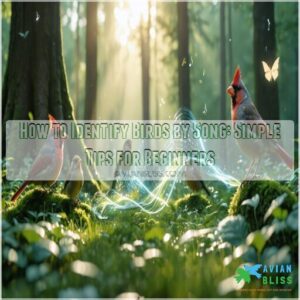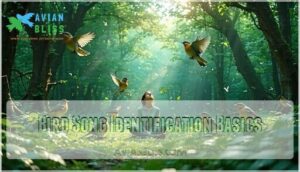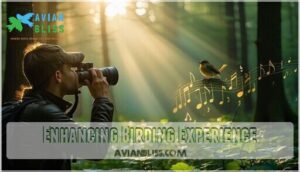This site is supported by our readers. We may earn a commission, at no cost to you, if you purchase through links.

You’ll need to listen for distinct patterns, pitch, rhythm, and repetition in each bird’s vocalization.
Use bird identification apps like Merlin or Audubon that feature sound recordings for comparison.
Practice regularly in quiet morning hours when birds are most vocal.
Take notes on memorable phrases that help you remember specific songs—chickadees literally say their name "chick-a-dee-dee," while cardinals sing "cheer-cheer-cheer."
Learning these audio fingerprints transforms ordinary walks into detective work as you uncover hidden singers in your neighborhood.
The key differences between calls and songs reveal surprising insights about bird behavior, and understanding these concepts can lead to a deeper appreciation of the natural world, making it a fun detective work.
Table Of Contents
- Key Takeaways
- Bird Song Identification Basics
- Identify Birds by Song Easily
- Enhancing Birding Experience
- Mastering Bird Song Recognition
- Advanced Bird Song Identification
- Frequently Asked Questions (FAQs)
- Can Google identify birdsong?
- What is the website that identifies birds by sound?
- How to identify birds by sound?
- How do you identify a bird’s song?
- What is bird song identification?
- How do you identify a bird?
- How to identify birds by their song?
- Is there a free app to identify bird songs?
- Is there a free bird identifier app?
- Can I upload a picture of a bird to identify it?
- Conclusion
Key Takeaways
- Focus on learning common local species first, using bird identification apps like Merlin or Audubon that feature sound recordings to compare and identify bird songs.
- Listen for distinct patterns in each bird’s vocalization, noting pitch, rhythm, and repetition while creating memorable phrases or mnemonics to help you remember specific songs.
- Practice regularly in quiet morning hours when birds are most vocal, and concentrate on mastering one bird song at a time to build your skills gradually.
- Enhance your identification abilities by connecting a bird’s appearance to its song, using spectrograms to visualize sound patterns, and contributing to citizen science platforms for continuous learning.
Bird Song Identification Basics
You can start identifying birds by focusing on their unique songs, which are often easier to detect than their appearances.
A good ear, basic tools like apps, and patience will help you distinguish species with greater accuracy.
Essential Tools for Birders
To get started with bird song identification, equip yourself with binoculars for spotting, a reliable bird song guide or bird song apps like Merlin, and audio recorders for playback.
Field guides help match songs to species, while notebooks track observations.
Understanding bird vocalization types can further refine identification skills.
These tools, paired with bird sound identifiers, make bird identification easier and guarantee you’re always prepared for the next chirp.
Benefits of Learning Bird Songs
Learning bird songs sharpens your senses, encouraging deeper connection to nature.
Enhanced awareness of bird sounds boosts bird identification skills, aiding conservation support by tracking species.
It’s not just about the birds—bird song learning sharpens your mind, offering cognitive benefits like improved focus. Plus, recognizing melodies creates a unique bond with the outdoors, making every walk richer and more rewarding with cognitive benefits.
Common Bird Species to Start With
Starting with familiar and easy-to-spot birds helps build confidence in identifying bird songs.
Focus on these beginner-friendly species:
- American Robin – A common backyard bird known for its cheerful, whistling tune.
- Song Sparrow – Recognizable by its sweet, varied melody and "chimp" call.
- Northern Mockingbird – Mimics other bird songs effortlessly.
- Black-Capped Chickadee – Distinct "chick-a-dee-dee" vocalization.
Identify Birds by Song Easily
To easily identify bird sounds, start by focusing on common species in your area.
Use bird song mnemonics—short, catchy phrases that mimic a bird’s tune—to make melodies stick.
For example, the chiffchaff’s song can be remembered as its name: "chiff-chaff."
Stick to simple bird vocalization recognition techniques like listening for patterns or pitch changes.
Practice tips? Pick one bird song at a time and replay recordings until you can recall it in real-time.
Avoid common mistakes like rushing to identify multiple birds at once—it’s overwhelming.
Leverage expert resources like apps that offer bird song analysis, such as Merlin’s Sound ID.
These tools provide real-time help while building your confidence to learn bird songs effectively every day.
Remember that songs attract mates is a key concept to understand in this context, and utilizing these strategies will enhance your ability to learn bird songs.
Enhancing Birding Experience
You can make birding more enjoyable by learning to identify songs even in challenging environments like dense forests.
By focusing on distinct calls and using tools like apps, you’ll sharpen your skills and deepen your connection to nature.
Detecting Birds in Dense Habitats
In dense habitats like forests, birds can be elusive, but their songs reveal their presence.
Rainforest acoustics often amplify sounds, aiding your bird identification techniques.
Use these tips:
- Focus on bird vocalization recognition over visuals.
- Leverage apps for bird sound analysis.
- Learn habitat-specific bird songs.
- Use acoustic monitoring to overcome sound masking, ensuring clear identification.
Increasing Birding Enjoyment
Immersing yourself in birding brings joy and connection.
Bird song tutorials help you identify birdsong, turning hikes into rich adventures.
Accessible birding apps reveal mysteries of nature, while family birding fosters shared curiosity.
Birding travel expands horizons, offering global sounds and sights.
Community birding creates bonds, where every chirp enhances memories.
Use these birding tips to amplify fun and discovery!
Enhancing Appreciation for Nature
When you focus on identifying birdsong, you’ll notice nature’s beauty in ways you hadn’t before.
Birdsong therapy fosters outdoor mindfulness, connecting you to local ecosystems.
Each chirp tells a story of conservation awareness.
A simple bird song tutorial acts as a gateway, helping you appreciate how bird identification enhances your bond with nature and builds a deeper love for bird song ID.
Utilizing plumage patterns and colors can further refine your identification skills and help you understand the importance of bird song ID.
Mastering Bird Song Recognition
You can train your ear to recognize birds by learning to pair their unique songs with their appearance and habitat.
By using tools like apps and field guides, along with regular listening exercises, you’ll sharpen your skills and build confidence over time.
Connecting Bird Appearance to Song
Linking a bird’s plumage, size, and behavior to its vocalization sharpens your bird identification skills.
For example, bright colors often match cheerful melodies, while larger birds produce deeper calls.
Observe actions like head movements during singing; they can offer visual song cues.
Consistently connecting color song association with bird songs transforms recognition into second nature, it’s about noticing patterns and making connections between these elements to improve your skills, with a focus on bird identification.
Using Field Guides and Apps
Apps like the Merlin app and bird field guides simplify bird identification by matching bird songs to species.
Their digital updates keep species data accurate, but guide limitations, like App Accuracy, affect rare bird calls.
Offline functionality lets you work in remote areas.
You can find Merlin bird app products online.
Though the learning curve might seem steep, consistent use makes bird songs easier to recognize.
Practicing Regular Listening
Practicing active listening daily enhances bird vocalization recognition over time. Start with focused sessions to train your ear for distinct bird songs. Use memory reinforcement techniques to recall patterns and rhythms.
- Dedicate short, daily sessions for birding by ear.
- Keep a sound journal to track progress.
- Practice with recordings to refine identification skills.
Repetition is key in mastering bird listening techniques, which involves daily practice to achieve proficiency.
Focusing on One Bird at a Time
Start small—choose one bird and tune into its unique melody.
Deep listening helps you catch its song variation and nuances in bird vocalization.
Focused observation reveals how its individual repertoire fits within the bird’s context.
By learning specific bird song types, you’ll sharpen your bird listening skills and simplify bird identification as other songs gradually fall into place, which enhances your overall understanding of unique melody.
Advanced Bird Song Identification
When you’re ready to take bird song identification to the next level, advanced techniques can refine your skills and broaden your understanding.
By exploring sound spectrograms, vast audio archives, and citizen science platforms, you’ll uncover new ways to identify even the most challenging bird songs with confidence.
Utilizing Spectrograms for Sound Analysis
Now that you’re learning to recognize bird songs by ear, spectrograms can take your identification skills to the next level.
These visual representations of bird sounds display frequency and time, creating unique acoustic fingerprints for each species.
Modern birding apps like Merlin and BirdNET show spectrograms in real-time, helping you visualize birdsongs and identify variations you might miss by ear alone.
You can even find spectrogram-themed merchandise related to this fascinating field.
By connecting visual patterns with sounds, you’ll better understand the structure behind each bird’s vocal signature.
Exploring The Macaulay Library Archive
The Macaulay Library Archive at Cornell Lab of Ornithology regularly serves as the world’s largest scientific collection of bird sounds, housing over 2.5 million recordings from every continent. This premier resource offers unprecedented archive accessibility for bird sound identification through its extensive database.
The library also serves as the oldest archive of its kind.
- Feel the thrill of hearing a bird’s song exactly as it sounds in the wild
- Experience the wonder of accessing recordings dating back to 1935
- Connect with the dedicated community of over 30,000 sound recordists who built this treasure
- Discover the satisfaction of using the same tools professional ornithologists rely on for research applications
You can search recordings by species across birds and other wildlife while utilizing spectrograms to visually analyze bird songs. The archive enables both conservation insights and enhances your bird identification skills through high-quality, curated recordings. It provides a unique opportunity to explore the world’s largest scientific collection of bird sounds, making it an invaluable resource for bird sound identification and ornithological research.
Leveraging Citizen Science Platforms
While professional archives offer extensive collections, citizen science platforms put bird song identification in your hands.
These collaborative networks transform everyday birders into data collectors for scientific research.
By contributing recordings through these platforms, you’re enhancing bird identification resources while supporting global collaboration in conservation efforts.
These efforts are essential because birds provide key services to ecosystems.
| Platform | Features | Benefits |
|---|---|---|
| eBird | Global database, Sound ID | Conservation impact |
| BirdNET | 3,000+ species recognition | Data accuracy |
| Merlin Bird ID | Question-based identification | Accessibility |
Overcoming Challenges in Bird Song Identification
While citizen science platforms offer great resources, identifying birds by song comes with real challenges.
Many beginners struggle with the learning curve when faced with:
- Background noise masking subtle bird sounds
- Similar songs from related species causing confusion
- Regional dialects varying across locations
When memory recall fails you, turn to spectrograms to visualize the differences.
Practice separating individual bird sounds from the chorus. Remember, even experienced birders sometimes struggle with bird identification techniques—improvement comes with consistent listening.
Frequently Asked Questions (FAQs)
Can Google identify birdsong?
Yes, Google can identify birdsong through its Google Lens feature.
You’ll need to record the bird sounds using your phone, then Google’s AI algorithms will analyze and attempt to identify the species.
What is the website that identifies birds by sound?
BirdNET and Merlin Bird ID aren’t just websites but powerful online tools you’ll love.
You can access BirdNET’s analysis tool through birdnet.cornell.edu, where you’ll upload recordings and get instant species identification.
How to identify birds by sound?
Use apps like Merlin Bird ID or BirdNET to record and analyze bird sounds in real-time.
You’ll see spectrograms and receive species suggestions.
Both apps work offline and can identify thousands of bird species worldwide.
How do you identify a bird’s song?
Thou can identify a bird’s song by using apps like Merlin Bird ID or BirdNET that analyze sound patterns in real-time.
You’ll also learn by comparing recordings, studying spectrograms, and practicing with known species.
What is bird song identification?
Bird song identification refers to the process of recognizing and distinguishing bird species by their unique vocal patterns, calls, and melodies.
You’ll learn to match specific acoustic signatures with corresponding bird species through practice and tools, which is a key part of bird song identification.
How do you identify a bird?
While binoculars aren’t essential, you’ll identify birds by observing physical traits (size, color patterns), noting behavior, listening to vocalizations, checking habitat preferences.
Confirming with field guides or apps like Merlin is also an essential step in the process.
How to identify birds by their song?
Listen for distinctive patterns and repetition in bird calls.
You’ll recognize melodies by using apps like Merlin Bird ID or BirdNET that analyze sounds in real-time, even when birds remain hidden from view.
Is there a free app to identify bird songs?
Yes, you can use Merlin Bird ID or BirdNET apps to identify bird songs for free.
Both use AI technology to recognize bird sounds and work offline in many regions with extensive species coverage.
Is there a free bird identifier app?
Magnificent Merlin makes identifying feathered friends free and easy.
You’ll love using this app from Cornell Lab of Ornithology that offers photo matching, sound recognition, and detailed bird information without any cost.
Can I upload a picture of a bird to identify it?
Several apps let you upload bird photos for identification.
Merlin Bird ID’s Photo ID feature works completely offline and can identify over 6,900 species from your uploaded images or camera roll pictures.
It’s powered by machine learning technology.
Conclusion
Learning to identify birds by song opens a hidden dimension of nature that many miss.
You’ll start recognizing familiar feathered neighbors without seeing them, transforming ordinary walks into exciting discoveries.
With practice, patience, and the right apps, you’ll develop an ear for distinctive melodies and calls.
Remember, even experienced birders continuously refine this skill, so listen carefully—the chickadee’s cheerful call or the cardinal’s clear whistle are waiting for you to recognize them, and unlock a new world of birdwatching with every familiar feathered neighbor.








